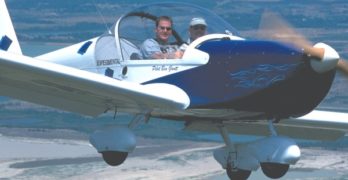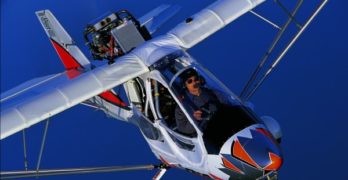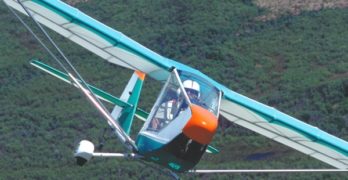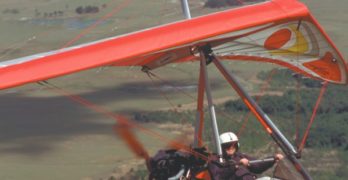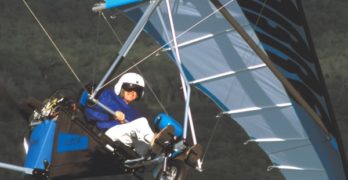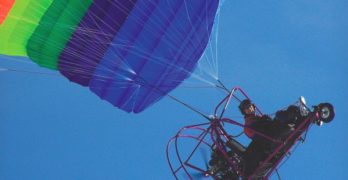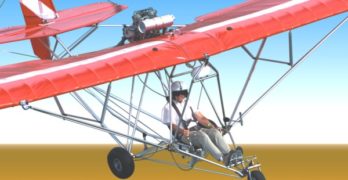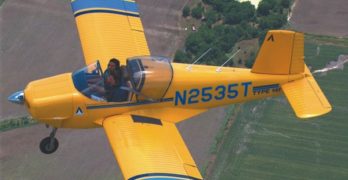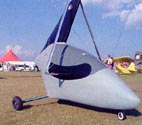The expression “seeing stars” is a good thing, if it means flying a delightful aircraft on a lovely day. After sampling the Sportstar in ’02 (see “Sportstar Pilot’s Report”, December ’02 Ultralight Flying!), I looked forward to a flight in its predecessor, the EV-97 Eurostar. You could say I had stars in my eyes. A blue Florida sky was dappled with miniature cumulus clouds, winds were mild, and the fuel tanks were full in a pretty blue-and-white Eurostar. I was ready.
On a beautiful Saturday, April 17, I flew the Evektor Eurostar with Nick Motlagh (pronounced “MOTE log”) – a sharp young aviator about to embark on a career in the air. He has been accepted to compete for fighter jet training in the Air Force after graduating from Embry Riddle Aeronautical University in Daytona Beach, Florida.
Motlagh had flown the Eurostar (N30167) over to South Lakeland Airpark to allow a flight review.
Search Results for : electric
Not finding exactly what you expected? Try our advanced search option.
Select a manufacturer to go straight to all our content about that manufacturer.
Select an aircraft model to go straight to all our content about that model.
Quicksilver’s GT500 Qualifier
Quicksilver’s GT 500 is ready for sport pilots
In the automotive world, GT stands for Grand Touring and that may be an appropriate comparison for the GT 500 from Quicksilver Aircraft Manufacturing. With the unlimited view from the front seat of this tandem two-seater, touring in the GT 500 is definitely a treat.
When the sport pilot/light-sport aircraft (SP/LSA) final rule arrives on the aviation scene, this top-of-the-line model from the longtime Southern California ultralight manufacturer may well be one of the first available ready-to-fly light-sport aircraft (LSA). Quicksilver co-owner Carl von Hirsch has indicated the company will build the GT 500 as a ready-to-fly Special LSA. It will also offer the strutbraced MX Sport IIS as a LSA entry.
You might say the GT 500 is preapproved; in 1993 the tandem, two-seat aircraft received both a type and production certificate in the Primary Category (see sidebar). It’s pretty safe to say that the design will quickly pass muster under the FAA-mandated LSA consensus standards under development by ASTM International.
It’s a Winner; CGS Hawk Sport
Given Chuck Slusarczyk’s decades in recreational aviation, I imagine almost everyone in ultralight aviation has heard of the funny, Polish-speaking pioneer with the hard-to-pronounce last name (Slew-Sar-Chick). If Chuck had named his first business Slusarczyk Glider Supplies, pilots would have stumbled and renamed it for him. Knowing his name is a tongue twister, he wisely called it Chuck’s Glider Supplies.
In his early business years, when Chuck was younger and slimmer, he made hang gliders. Lots and lots of hang gliders. I flew one, as did thousands of others. He was one of a handful of east-of-the-Mississippi hang glider manufacturers. Being a long way from the West Coast where hang gliding was centered back in the ’70s, Chuck made the Californians nervous. They couldn’t keep an eye on his developments and he was regarded as unpredictable. Those who knew him thought the word should be innovative.
Then came powered hang gliding, such as it was in those days.
Clipper 912 with iXess Wing and Fun 450
After flying all their models, after visiting with company representatives on several occasions, and after visiting the factory in Aubenau, France, I feel like I know the Air Création people. So I should have known they wouldn’t just make a new wing purely for marketing reasons.
Indeed, when I few the iXess after flying their new Fun 450 wing (also reported in this article), I came away with that same head-shaking-in-wonder feeling that has affected me before. I know a little something about delta wing design, having been around hang gliding since the early 1970s, and trikes since their beginning. That helps me to comprehend how far these wings have progressed and how much harder it is to extract additional gains year after year.
Trike wings (and hang gliders) generally trade more glide or speed performance for handling ease. At least, that was how it used to be. Today, that statement must be modified to reflect the surprising capacity of modern wing designers to find more performance at the same time they refine the handling.
Sabre’s New Wildcat
Smoother and More Refined
Sabre Aircraft’s Wildcat is an evolving story of ultralight aircraft development. It also speaks to the increasing maturity of the light aviation industry.
For years, Sabre Aircraft’s sales of their various trike models may have been the largest of any U.S. manufacturer. As 2003 ended the company was reporting delivery of some 700 ultralights.
The company has long offered a good flying, simple trike with a modest price tag. Proprietor and designer Richard Helm made steady improvements to his Sabre Elite and Sabre 340 designs. But he took no major strides forward.
The vigorous pace of Sabre trike sales and the company’s need to stay on top of manufacturing issues can explain a drawn-out development period. Little time was left over for projects such as getting an entirely new trike ready for market.
That didn’t stop Helm. He kept working on elements of what would eventually become the Wildcat.
Blue Heron Marathon
Built lighter to fly better
It may be hard to believe that a company established in 1995 can be considered an old-timer in an industry, yet that’s precisely the case with Heldeberg Designs LLC and its line of Blue Heron powered parachutes (PPCs).
Nick and Marie Viscio founded Heldeberg Designs a decade ago and believe they are the second oldest, continuously operating powered parachute company in America. Only Six Chuter has a longer history under the same management and ownership.
Nick and Marie run the enterprise with help from son Nicholas D., who has a degree in mechanical and aeronautical engineering, and three part-time employees assisting with fabrication and welding. “Nick is very hands-on in operating the company,” said Mark Bayer, Heldeberg’s New York dealer with whom I flew at Sun’n Fun 2004. He added, “They’re not trying to be the biggest manufacturer, just the best.”
Why did the company choose the Blue Heron name for its machines?
Breese With HKS Engine Is A Winner
Twenty-something years of ultralight flying have seen many changes take place in our ultralights. At the beginning of the ultralight industry we had craft such as Eagles, Weedhoppers, and Quicksilvers powered by engines like the 15-hp Yamaha, Mac 101, and Chrysler. Of these, only Quicksilver remains vibrant.
Here in 2004, we have aircraft like the Breese DS with its 60-hp HKS 700E 4-stroke engine. It may look like a Quicksilver but it’s a different flying animal. M-Squared’s Jay Stevens gave me a checkout in the single-seat Breese with its Japanese 4-stroke powerplant and it proved to be a very satisfying experience.
Strong and Powerful
The resemblance to Quicksilver, especially the California company’s strut-braced model, is obvious to most ultralight veterans but Breese manufacturer M-Squared has steadily changed their design. Looks, therefore, can be deceiving.
The use of struts first set apart the designs of Paul Mather, proprietor of M-Squared. A tailplane that uses no cable bracing added to the different appearance.
Thorp T-211
Thorp T-211 Sport E
From the world of general aviation aircraft comes an entry to the proposed Light-Sport Aircraft (LSA) category. Presently known as the Thorp T-211, the all-metal airplane will be called the Thorp T-211 Sport E when it makes its debut as a light-sport aircraft.
Famed designer John Thorp is perhaps best known for his work leading to the Piper Cherokee series and the T-18 homebuilt. His work on a design that became the T-211 started back in the 1940s before general aviation planes had transportation as their primary goal. When the T-211 was first created – as the T-11 Skooter and later the T-111 – it was intended to become competition for the Cessna 150. The T-211 is a light plane, tipping the scales at hundreds of pounds less than Cessna’s smallest model and so it was expected to perform better.
Under new management since 2003, Thorp’s design is ready to make the leap to the Sport E.
Part 103 Ultralight Trikes
Part 103 ultralight trikes aim at soaring pilots.
Many visitors to Oshkosh AirVenture 2003 expected the FAA to announce its new sport pilot/light-sport aircraft rule. New Administrator Marion Blakey reported signing off on the rule on July 30, but with two other agencies in line to review it, we aren’t likely to see the final version until 2004.
Visitors may not have expected to see more than a few Part 103 ultralight aircraft at AirVenture (some thought they would disappear as LSA approaches). But there were many. Next month I’ll write about two Part 103 rotary-wing aircraft, but this time, the subject is nanotrikes.
Nanotrike is a term to describe extremely light wheeled structures combining powered paraglider engines and contemporary hang glider wings. The idea is to create a low-cost, self-launching ultralight motorglider.
Trike Pod
Minnesota-based Seagull Aerosports debuted its Escape Pod at Oshkosh. Pushed by a single-cylinder Cors-Air engine generating 25 hp, the Escape Pod weighs only 75 pounds.
Product Lines – April 2004
St. Paul, Minn. — You’ll probably be amazed to hear that Wallaby Ranch and Quest
have merged. Yes, unbelievably, the two rivals flight parks signed an agreement
to become as one. This stunning development comes just
after Wills Wing purchased Moyes “for a song” crooned WW president, Rob Kells.
“It seemed like a good idea at the time,” he added. How much more shocking news can
you withstand? Well, in keeping with a few fun items elsewhere in this magazine,
the above is pure April Fools fiction. I’ll leave more inventive humor to others
and return to what this column does best.
Amid all the excitement, I completely forgot to blow my own horn| Yup, with the February
2004 issue, “Product Lines” finished 25 years of continuous publishing. In
all that time, the column never missed an issue. As I am working to post all
these columns on my long-in-development Web site, someday you’ll be able to scan
through a lot of hang gliding history presented in a familiar format.
- « Previous Page
- 1
- …
- 55
- 56
- 57
- 58
- 59
- …
- 67
- Next Page »


